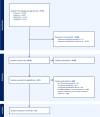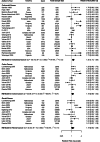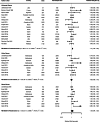Systematic Analysis of the Differential Effects of Red Meat on Colorectal Cancer Risks: A Meta-Analytic Approach
- PMID: 40773080
- PMCID: PMC12331815
- DOI: 10.1007/s12029-025-01247-3
Systematic Analysis of the Differential Effects of Red Meat on Colorectal Cancer Risks: A Meta-Analytic Approach
Abstract
Objectives: Colorectal cancer (CRC) is the third most common cancer worldwide, with rising incidence in younger populations. Red meat consumption has been proposed as a risk factor for CRC, though the evidence remains inconsistent. This systematic review and meta-analysis aimed to examine the associations between the consumption of beef, pork, and lamb with CRC, colon cancer (CC), and rectal cancer (RC) risk.
Methods: The findings from 27 studies published between 1993 and 2024 were included, involving over 1 million participants from diverse geographical regions. Relative risks were calculated using random-effects meta-analysis, with subgroup and meta-regression analyses performed to assess potential sources of heterogeneity.
Results: Beef consumption was significantly associated with increased CRC risk, with a 30% overall risk increase (95% CI: 1.10-1.54). The association with colon cancer (CC) was marginally significant (RR = 1.19, 95% CI: 0.99-1.43, p = 0.0585), while the link to rectal cancer (RC) was not statistically significant. Pork consumption was associated with a 17% increased CRC risk (95% CI: 1.09-1.25), with similar, nonsignificant trends for CC and RC. Lamb consumption was weakly associated with an 11% increase in CRC risk (95% CI: 1.02-1.21), though this was based on limited studies (n = 6), and no significant associations emerged for cancer subtypes. Study design and confounding factors influenced these associations, with case-control studies reporting stronger associations than cohort studies. Physical activity adjustments were pivotal, as studies without this adjustment consistently reported higher-risk estimates.
Conclusion: These findings emphasise the importance of accounting several lifestyle factors in future research and public health guidance. While these results support current dietary guidelines recommending limited red meat consumption, they also underscore the complexity of diet-cancer relationships and the need for comprehensive, lifestyle-inclusive cancer prevention strategies.
Keywords: Beef; Colorectal cancer; Dietary risk factors; Lamb; Pork; Red meat.
© 2025. The Author(s).
Conflict of interest statement
Declarations: Ethics Approval and Consent to Participate. Not applicable. Consent for Publication: Not applicable. Conflict of Interest: The authors declare no competing interests.
Figures












Similar articles
-
Meat subtypes and their association with colorectal cancer: Systematic review and meta-analysis.Int J Cancer. 2016 Jan 15;138(2):293-302. doi: 10.1002/ijc.29423. Epub 2015 Feb 24. Int J Cancer. 2016. PMID: 25583132
-
Association between red and processed meat consumption and colorectal cancer risk: a comprehensive meta-analysis of prospective studies.Geroscience. 2025 Jun;47(3):5123-5140. doi: 10.1007/s11357-025-01646-1. Epub 2025 Apr 10. Geroscience. 2025. PMID: 40210826 Free PMC article.
-
Selenium for preventing cancer.Cochrane Database Syst Rev. 2018 Jan 29;1(1):CD005195. doi: 10.1002/14651858.CD005195.pub4. Cochrane Database Syst Rev. 2018. PMID: 29376219 Free PMC article.
-
Chemoprevention of colorectal cancer: systematic review and economic evaluation.Health Technol Assess. 2010 Jun;14(32):1-206. doi: 10.3310/hta14320. Health Technol Assess. 2010. PMID: 20594533
-
Meat consumption and colorectal cancer risk: an evaluation based on a systematic review of epidemiologic evidence among the Japanese population.Jpn J Clin Oncol. 2014 Jul;44(7):641-50. doi: 10.1093/jjco/hyu061. Epub 2014 May 19. Jpn J Clin Oncol. 2014. PMID: 24842864
References
-
- OurWorldInData.org. 2023. https://ourworldindata.org/causes-of-death. Accessed 03/03/2024
-
- Ferlay J EM, Lam F, Laversanne M, Colombet M, Mery L, Piñeros M, Znaor A, Soerjomataram I, Bray F: Global Cancer Observatory: Cancer Today. Lyon, France: International Agency for Research on Cancer. https://gco.iarc.who.int/today (2024). Accessed Oct 30 2024.
-
- Siegel RL, Wagle NS, Cercek A, Smith RA, Jemal A. Colorectal cancer statistics, 2023. CA: A Cancer Journal for Clinicians. 2023;73(3):233–54. 10.3322/caac.21772. - PubMed
Publication types
MeSH terms
LinkOut - more resources
Full Text Sources
Medical
